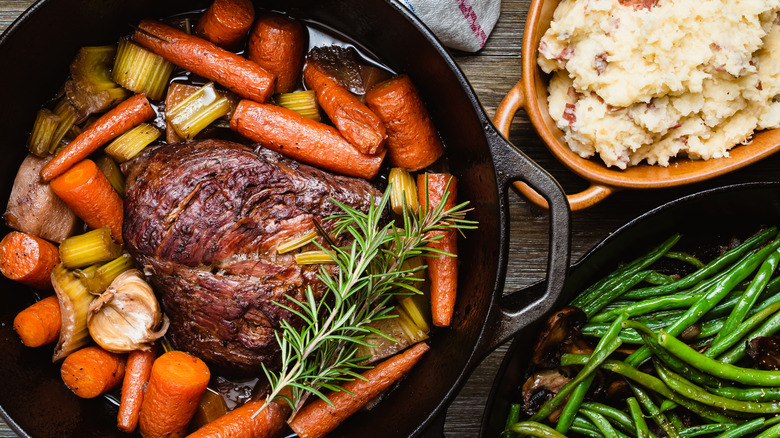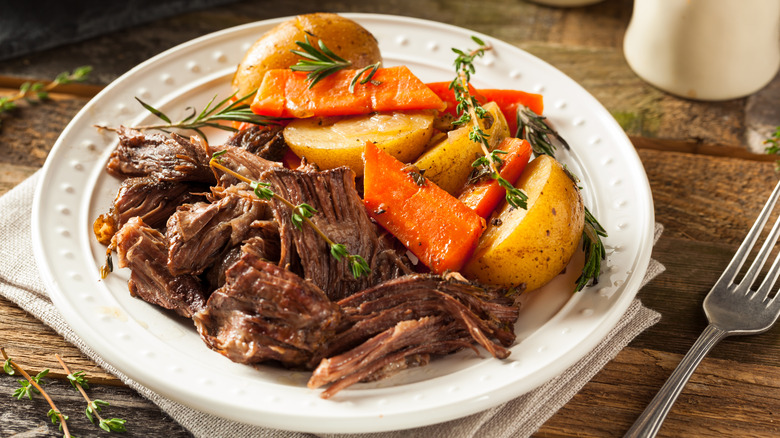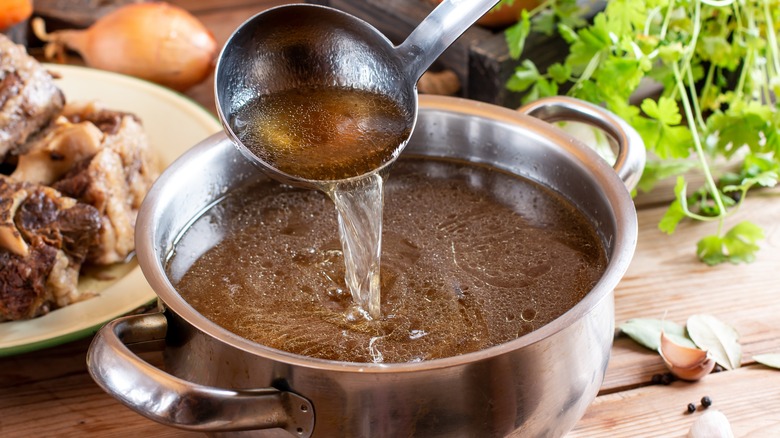Pot Roast Doesn't Have To Be Completely Submerged In Liquid For A Perfect Cook
Pot roast is a classic, crowd-pleasing, downhome meal that the whole family can enjoy. Hearty, tender, and satiating, pot roast can be customized in dozens of ways to suit your unique preferences and tastes. Whether you make a Mississippi pot roast, a red wine-braised roast, or a roast perfect for a Sunday evening, there's no wrong way to enjoy the vibrant, umami-blasted flavors. Although there may be no wrong way to enjoy this one-pot classic, there are cooking tips that can help you make a high-quality pot roast every time. One of the best is that there's no need to fully submerge the roast in the cooking liquid.
Pot roast is prepared using a braising method, which involves slow-cooking meat in a liquid such as stock or red wine. If you add too much liquid, the meat might end up boiling instead of braising. Boiling meat can result in an unappealing texture and won't allow the development of the rich, complex flavors that braising provides.
Too much liquid in the roast slows the cooking process because the excess liquid needs to reach the right temperature before it can cook the meat. Excess liquid also dilutes the flavors of pot roast — you want the seasonings and aromatics to integrate primarily with the meat, not the cooking liquid. Making a pot roast is an easy but time-consuming process, so it's important to avoid making mistakes that could add even more time to the operation.
Prevent the roast from drying out
Although you don't want soggy, under-cooked, and mild-flavored roast from using too much cooking liquid, you certainly don't want to end up with a dry roast, either. However, if you're not a pot roast professional, you may inadvertently oversaturate your roast in an attempt to prevent it from drying out. As with all recipes, it's about using the right ingredients in the right balance.
The cut of beef is arguably the most important ingredient in a pot roast because the right cut can help lower the chances of a dry roast. Opt for cuts that are well-marbled with fat, as fat adds flavor and keeps the meat moist during cooking. Chuck roast is often considered synonymous with pot roast, but cross rib, shoulder, brisket, blade, or short rib are also excellent options for braising.
Depending on the size of your chosen cut of meat, from 1 inch to 1 or 2 cups of liquid should be plenty to yield a moist, tender, melt-in-your-mouth pot roast. As tempting as it may be, don't remove the lid from your slow cooker when the roast cooks down, as the liquid continues to release steam and moisture throughout the cooking process, which is crucial to keeping the meat succulent.
Best liquids to use
When cooking a pot roast, your choice of cooking liquid plays a key role in defining the unique flavors of the pot roast. Beef broth, with its rich and savory notes, is a classic option, and the also popular red wine can add complexity and acidity, which elevates the overall flavor profile. Alternatively, vegetable broth offers a lighter profile, ideal for those seeking to balance the heavier flavors in the roast. Dark beer introduces robustness and depth, and tomato-based liquids contribute hints of sweetness and tanginess. The unexpected choice of coffee or espresso can infuse the roast with a surprisingly delicious essence that complements red meat. For an even richer flavor, you can use one part butter and one part liquid in your pot roast.
The beauty of pot roast lies in its adaptability to various cooking liquids, meaning there isn't a one-size-fits-all rule in selecting a cooking liquid. Ultimately, it depends on your preferences and the flavor profile you're aiming to build in your roast, so have fun with it, and don't be afraid to be bold.
Just remember there is no need to fully submerge your roast in liquid — a little goes a long way to making a moist and fork-tender pot roast.


